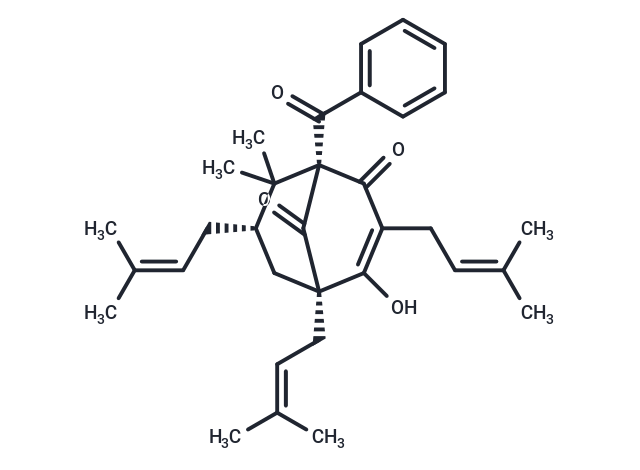 Your shopping cart is currently empty
Your shopping cart is currently empty

Nemorosone is a polycyclic polyprenylated acylphloroglucinol (PPAP) originally isolated from C. rosea that has antiproliferative properties.1 Nemorosone inhibits growth of NB69, Kelly, SK-N-AS, and LAN-1 neuroblastoma cells (IC50s = 3.1-6.3 μM), including several drug-resistant clones, but not MRC-5 human embryonic fibroblasts (IC50 = >40 μM).2 It increases DNA fragmentation in LAN-1 cells in a dose-dependent manner, and decreases N-Myc protein levels and phosphorylation of ERK1/2 by MEK1/2. Nemorosone also inhibits growth of Capan-1, AsPC-1, and MIA-PaCa-2 pancreatic cancer cells (IC50s = 4.5-5.0 μM following a 72-hour treatment) but not human dermal and foreskin fibroblasts (IC50s = >35 μM).1 It induces apoptosis, abolishes the mitochondrial membrane potential, and increases cytosolic calcium concentration in pancreatic cancer cells in a dose-dependent manner. Nemorosone activates the caspase cascade in a dose-dependent manner and inhibits cell cycle progression, increasing the proportion of cells in the G0/G1 phase, in both neuroblastoma and pancreatic cancer cells.1,2 Nemorosone (50 mg/kg, i.p., per day) also reduces tumor growth in an MIA-PaCa-2 mouse xenograft model.3

| Pack Size | Price | USA Warehouse | Global Warehouse | Quantity |
|---|---|---|---|---|
| 1 mg | $159 | 35 days | 35 days | |
| 5 mg | $548 | 35 days | 35 days | |
| 10 mg | $932 | 35 days | 35 days |
| Description | Nemorosone is a polycyclic polyprenylated acylphloroglucinol (PPAP) originally isolated from C. rosea that has antiproliferative properties.1 Nemorosone inhibits growth of NB69, Kelly, SK-N-AS, and LAN-1 neuroblastoma cells (IC50s = 3.1-6.3 μM), including several drug-resistant clones, but not MRC-5 human embryonic fibroblasts (IC50 = >40 μM).2 It increases DNA fragmentation in LAN-1 cells in a dose-dependent manner, and decreases N-Myc protein levels and phosphorylation of ERK1/2 by MEK1/2. Nemorosone also inhibits growth of Capan-1, AsPC-1, and MIA-PaCa-2 pancreatic cancer cells (IC50s = 4.5-5.0 μM following a 72-hour treatment) but not human dermal and foreskin fibroblasts (IC50s = >35 μM).1 It induces apoptosis, abolishes the mitochondrial membrane potential, and increases cytosolic calcium concentration in pancreatic cancer cells in a dose-dependent manner. Nemorosone activates the caspase cascade in a dose-dependent manner and inhibits cell cycle progression, increasing the proportion of cells in the G0/G1 phase, in both neuroblastoma and pancreatic cancer cells.1,2 Nemorosone (50 mg/kg, i.p., per day) also reduces tumor growth in an MIA-PaCa-2 mouse xenograft model.3 |
| Molecular Weight | 502.695 |
| Formula | C33H42O4 |
| Cas No. | 351416-47-2 |
| Smiles | [#6]\[#6](-[#6])=[#6]\[#6]-[#6@H]1-[#6][C@]2([#6]\[#6]=[#6](\[#6])-[#6])[#6](-[#8])=[#6](-[#6]\[#6]=[#6](\[#6])-[#6])-[#6](=O)[C@@]([#6](=O)-c3ccccc3)([#6]2=O)C1([#6])[#6] |t:14| |
| Storage | Powder: -20°C for 3 years | In solvent: -80°C for 1 year | Shipping with blue ice/Shipping at ambient temperature. |
| Solubility Information | Ethanol: 30 mg/mL (59.68 mM), Sonication is recommended. DMSO: 30 mg/mL (59.68 mM), Sonication is recommended. Ethanol:PBS (pH7.2) (1:7): 0.13 mg/mL (0.26 mM), Sonication is recommended. DMF: 30 mg/mL (59.68 mM), Sonication is recommended. |
| Size | Quantity | Unit Price | Amount | Operation |
|---|

Copyright © 2015-2026 TargetMol Chemicals Inc. All Rights Reserved.